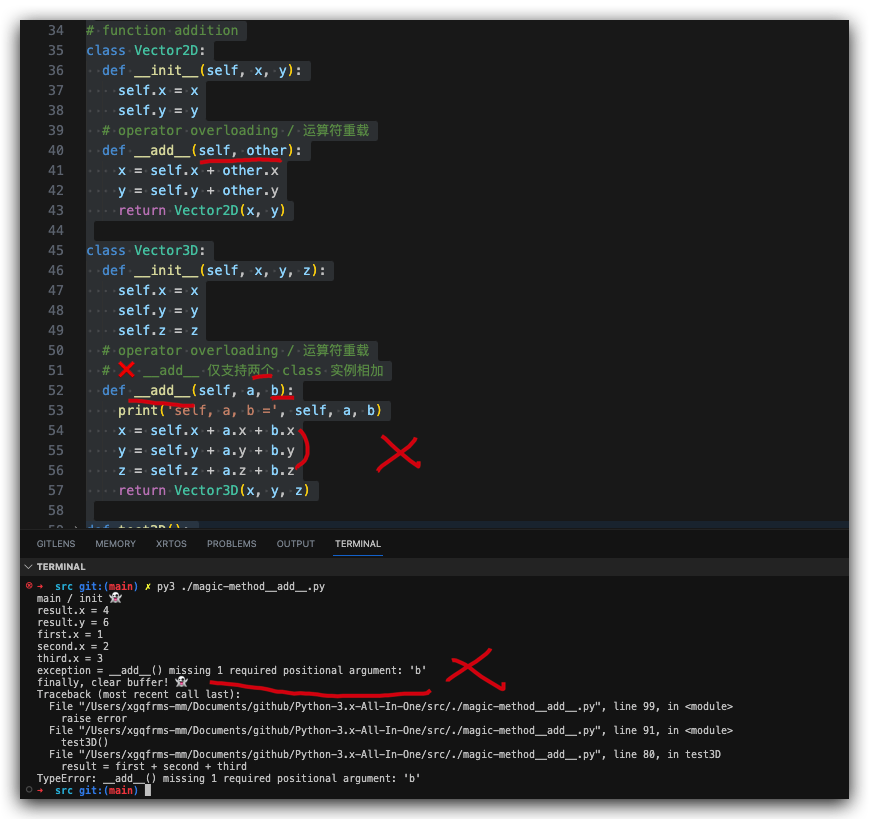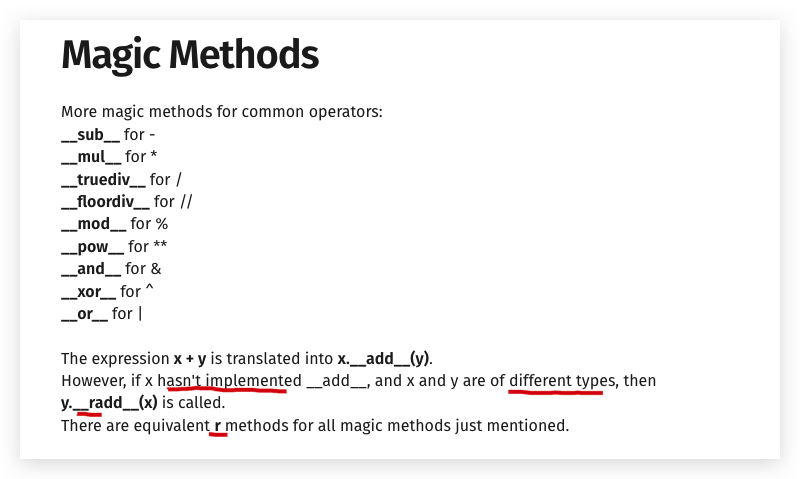Python Magic Methods & Operator Overloading All In One
Python Magic Methods & Operator Overloading All In One
__init__&__add__

Magic Methods
__sub__ for -
__mul__ for *
__truediv__ for /
__floordiv__ for //
__mod__ for %
__pow__ for **
__and__ for &
__xor__ for ^
__or__ for |

The expression x + y is translated into x.__add__(y).
However, if x hasn't implemented add, and x and y are of different types, then y.__radd__(x) is called.
There are equivalent r methods for all magic methods just mentioned.
__rsub__ for -
__rmul__ for *
__rtruediv__ for /
__rfloordiv__ for //
__rmod__ for %
__rpow__ for **
__rand__ for &
__rxor__ for ^
__ror__ for |
https://www.sololearn.com/learn/courses/python-intermediate/lesson/912154723?p=3
Python also provides magic methods for comparisons.
__lt__ for <
__le__ for <=
__eq__ for ==
__ne__ for !=
__gt__ for >
__ge__ for >=
If __ne__ is not implemented, it returns the opposite of __eq__.
There are no other relationships between the other operators.
https://www.sololearn.com/learn/courses/python-intermediate/lesson/912154723?p=5
There are several magic methods for making classes act like containers.
__len__ for len()
__getitem__ for indexing
__setitem__ for assigning to indexed values
__delitem__ for deleting indexed values
__iter__ for iteration over objects (e.g., in for loops)
__contains__ for in
There are many other magic methods that we won't cover here, such as __call__ for calling objects as functions, and __int__, __str__, and the like, for converting objects to built-in types.
https://www.sololearn.com/learn/courses/python-intermediate/lesson/912154723?p=7
demos
add
#!/usr/bin/env python3
# coding: utf8
__author__ = 'xgqfrms'
__editor__ = 'vscode'
__version__ = '1.0.1'
__github__ = 'https://github.com/xgqfrms/Raspberry-Pi'
__git__ = 'https://github.com/xgqfrms/Raspberry-Pi.git'
__copyright__ = """
Copyright (c) 2012-2050, xgqfrms; mailto:xgqfrms@xgqfrms.xyz
"""
"""
/**
*
* @author xgqfrms
* @license MIT
* @copyright xgqfrms
* @created 2020-01-01
* @updated 2023-07-01
*
* @description
* @augments
* @example
* @link
*
*/
"""
# print("Hello, Python 3 🐍")
# function addition
class Vector2D:
def __init__(self, x, y):
self.x = x
self.y = y
# operator overloading / 运算符重载
def __add__(self, other):
x = self.x + other.x
y = self.y + other.y
return Vector2D(x, y)
class Vector3D:
def __init__(self, x, y, z):
self.x = x
self.y = y
self.z = z
# operator overloading / 运算符重载
# ❌ __add__ 仅支持两个 class 实例相加
def __add__(self, a, b):
print('self, a, b =', self, a, b)
x = self.x + a.x + b.x
y = self.y + a.y + b.y
z = self.z + a.z + b.z
return Vector3D(x, y, z)
def test2D():
first = Vector2D(1, 2)
second = Vector2D(3, 4)
# print('first =', first)
# print('first.x =', first.x)
# print('second =', second)
# print('second.x =', second.x)
# ✅ 自动调用 __add__
result = first + second
# print('result =', result)
print('result.x =', result.x)
print('result.y =', result.y)
def test3D():
first = Vector3D(1, 1, 1)
second = Vector3D(2, 2, 2)
third = Vector3D(3, 3, 3)
print('first.x =', first.x)
print('second.x =', second.x)
print('third.x =', third.x)
# ❌ exception = __add__() missing 1 required positional argument: 'b'
result = first + second + third
print('result =', result)
# print('result.x =', result.x)
# print('result.y =', result.y)
# print('result.z =', result.z)
if __name__ == '__main__':
print('main / init 👻')
try:
test2D()
test3D()
except KeyboardInterrupt:
print('Ctrl + C exit ✅')
except RuntimeError as error:
print('error =', error, error.args[0])
pass
except Exception as error:
print('exception =', error)
raise error
finally:
# cleanup
print('finally, clear buffer! 👻')
# print('exit Python REPL')
exit()
'''
# $ python3 ./magic-method__add__.py
$ py3 ./magic-method__add__.py
main / init 👻
result.x = 4
result.y = 6
first.x = 1
second.x = 2
third.x = 3
exception = __add__() missing 1 required positional argument: 'b'
finally, clear buffer! 👻
Traceback (most recent call last):
File "/Users/xgqfrms-mm/Documents/github/Python-3.x-All-In-One/src/./magic-method__add__.py", line 99, in <module>
raise error
File "/Users/xgqfrms-mm/Documents/github/Python-3.x-All-In-One/src/./magic-method__add__.py", line 91, in <module>
test3D()
File "/Users/xgqfrms-mm/Documents/github/Python-3.x-All-In-One/src/./magic-method__add__.py", line 80, in test3D
result = first + second + third
'''
radd
#!/usr/bin/env python3
# coding: utf8
__author__ = 'xgqfrms'
__editor__ = 'vscode'
__version__ = '1.0.1'
__github__ = 'https://github.com/xgqfrms/Raspberry-Pi'
__git__ = 'https://github.com/xgqfrms/Raspberry-Pi.git'
__copyright__ = """
Copyright (c) 2012-2050, xgqfrms; mailto:xgqfrms@xgqfrms.xyz
"""
"""
/**
*
* @author xgqfrms
* @license MIT
* @copyright xgqfrms
* @created 2020-01-01
* @updated 2023-07-01
*
* @description
* @augments
* @example
* @link
*
*/
"""
# print("Hello, Python 3 🐍")
# function addition
class ClassA:
def __init__(self, x, y):
self.x = x
self.y = y
# 没有的定义 __add__ 🚀
class ClassB:
def __init__(self, x, y):
self.x = x
self.y = y
# operator overloading / 运算符重载
def __add__(self, other):
x = self.x + other.x
y = self.y + other.y
return ClassB(x, y)
def testAB():
x = ClassA(1, 1)
y = ClassB(2, 2)
# ❌ exception = unsupported operand type(s) for +: 'ClassA' and 'ClassB'
# result = x + y
# ❌ exception = 'ClassA' object has no attribute '__radd__'
# result = x.__radd__(y)
# ❌ exception = 'ClassB' object has no attribute '__radd__'
# result = y.__radd__(x)
# ✅
# result = y.__add__(x)
# ✅
result = y + x
# print('result =', result)
print('result.x =', result.x)
print('result.y =', result.y)
class ClassC:
def __init__(self, x, y):
# 不同类型 string
self.x = str(x) + ""
self.y = str(y) + ""
# ✅ fix: int + str bug
# self.x = x + ""
# self.y = y + ""
# 没有的定义 __add__
class ClassD:
def __init__(self, x, y):
# 不同类型 int
self.x = x
self.y = y
# 没有的定义 __add__
# # 定义 __radd__ ✅
def __radd__(self, other):
x = self.x + int(other.x)
y = self.y + int(other.y)
# fix: 类型转换 ✅
# x = self.x + other.x
# y = self.y + other.y
return ClassD(x, y)
def testCD():
# 不同类型 __radd__ ✅
x = ClassC(1, 1)
y = ClassD(2, 2)
# ✅
# result = x + y
# ✅
result = y.__radd__(x)
# ❌ exception = __radd__() takes 2 positional arguments but 3 were given
# result = y.__radd__(y, x)
# print('result =', result)
print('result.x =', result.x)
print('result.y =', result.y)
class ClassR:
def __init__(self, x, y):
self.x = x
self.y = y
# 没有的定义 __add__
# # 定义 __radd__ ✅
def __radd__(self, other):
x = self.x + other.x
y = self.y + other.y
return ClassR(x, y)
def test():
# 💩 相同类型呀
x = ClassR(1, 1)
y = ClassR(2, 2)
# ❌ exception = unsupported operand type(s) for +: 'ClassR' and 'ClassR'
# result = x + y
# result = y.__radd__(x)
result = x.__radd__(y)
# print('result =', result)
print('result.x =', result.x)
print('result.y =', result.y)
if __name__ == '__main__':
print('main / init 👻')
try:
i = 1
s = ""
ok = str(i) + s
print('✅ ok =', ok)
# ❌ TypeError: unsupported operand type(s) for +: 'int' and 'str'
# bug = i + s
# print('❌ bug =', bug)
# testAB()
testCD()
# test()
except KeyboardInterrupt:
print('Ctrl + C exit ✅')
except RuntimeError as error:
print('error =', error, error.args[0])
pass
except Exception as error:
print('exception =', error)
raise error
finally:
# cleanup
print('finally, clear buffer! 👻')
# print('exit Python REPL')
exit()
'''
# $ python3 ./magic-method__radd__.py
$ py3 ./magic-method__radd__.py
main / init 👻
result.x = 3
result.y = 3
finally, clear buffer! 👻
'''
truediv
#!/usr/bin/env python3
# coding: utf8
__author__ = 'xgqfrms'
__editor__ = 'vscode'
__version__ = '1.0.1'
__github__ = 'https://github.com/xgqfrms/Raspberry-Pi'
__git__ = 'https://github.com/xgqfrms/Raspberry-Pi.git'
__copyright__ = """
Copyright (c) 2012-2050, xgqfrms; mailto:xgqfrms@xgqfrms.xyz
"""
"""
/**
*
* @author xgqfrms
* @license MIT
* @copyright xgqfrms
* @created 2020-01-01
* @updated 2023-07-01
*
* @description
* @augments
* @example
* @link
*
*/
"""
class SpecialString:
def __init__(self, strs):
self.strs = strs
def __truediv__(self, other):
# text = "".join([self.strs, ' ', other.strs])
text = self.strs + ' ' + other.strs
line = "=" * len(text)
return "\n".join([line, text])
spam = SpecialString("Hello")
hello = SpecialString("world!")
test = spam / hello
print(test)
"""
$ py3 ./magic-method__truediv__.py
============
Hello world!
"""
#!/usr/bin/env python3
# coding: utf8
__author__ = 'xgqfrms'
__editor__ = 'vscode'
__version__ = '1.0.1'
__github__ = 'https://github.com/xgqfrms/Raspberry-Pi'
__git__ = 'https://github.com/xgqfrms/Raspberry-Pi.git'
__copyright__ = """
Copyright (c) 2012-2050, xgqfrms; mailto:xgqfrms@xgqfrms.xyz
"""
"""
/**
*
* @author xgqfrms
* @license MIT
* @copyright xgqfrms
* @created 2020-01-01
* @updated 2023-07-01
*
* @description
* @augments
* @example
* @link
*
*/
"""
import random
class VagueList:
def __init__(self, arr):
self.arr = arr
def __getitem__(self, index):
return self.arr[index + random.randint(-1, 1)]
def __len__(self):
return random.randint(0, len(self.arr)*2)
vague_list = VagueList(["A", "B", "C", "D", "E"])
print(len(vague_list))
print(len(vague_list))
print(vague_list[2])
print(vague_list[2])
"""
$ py3 ./magic-method__len__.py
"""
运算符函数
operator 模块提供了一套与 Python 的内置运算符对应的高效率函数。例如,operator.add(x, y) 与表达式 x+y 相同。
函数包含的种类有:对象的比较运算、逻辑运算、数学运算以及序列运算。
对象比较函数适用于所有的对象,函数名根据它们对应的比较运算符命名。
许多函数名与特殊方法名相同,只是没有双下划线。
为了向后兼容性,也保留了许多包含双下划线的函数,为了表述清楚,建议使用没有双下划线的函数。
# Python 实例
# add(), sub(), mul()
# 导入 operator 模块
import operator
# 初始化变量
a = 4
b = 3
# 使用 add() 让两个值相加
print ("add() 运算结果 :",end="");
print (operator.add(a, b))
# 使用 sub() 让两个值相减
print ("sub() 运算结果 :",end="");
print (operator.sub(a, b))
# 使用 mul() 让两个值相乘
print ("mul() 运算结果 :",end="");
print (operator.mul(a, b))
https://www.runoob.com/python3/python-operator.html
refs
https://www.runoob.com/python3/python3-function.html
REPL
https://www.runoob.com/try/runcode.php?filename=HelloWorld&type=python3
©xgqfrms 2012-2021
www.cnblogs.com/xgqfrms 发布文章使用:只允许注册用户才可以访问!
原创文章,版权所有©️xgqfrms, 禁止转载 🈲️,侵权必究⚠️!
本文首发于博客园,作者:xgqfrms,原文链接:https://www.cnblogs.com/xgqfrms/p/17565339.html
未经授权禁止转载,违者必究!



【推荐】国内首个AI IDE,深度理解中文开发场景,立即下载体验Trae
【推荐】编程新体验,更懂你的AI,立即体验豆包MarsCode编程助手
【推荐】抖音旗下AI助手豆包,你的智能百科全书,全免费不限次数
【推荐】轻量又高性能的 SSH 工具 IShell:AI 加持,快人一步
· 被坑几百块钱后,我竟然真的恢复了删除的微信聊天记录!
· 【自荐】一款简洁、开源的在线白板工具 Drawnix
· 没有Manus邀请码?试试免邀请码的MGX或者开源的OpenManus吧
· 园子的第一款AI主题卫衣上架——"HELLO! HOW CAN I ASSIST YOU TODAY
· 无需6万激活码!GitHub神秘组织3小时极速复刻Manus,手把手教你使用OpenManus搭建本
2022-07-19 Quick source viewer All In One
2022-07-19 webfullstack All In One
2022-07-19 Bun JavaScript runtime All In One
2022-07-19 华为账号隐私中心 All In One
2021-07-19 js 如何在二维码上添加 logo All In One
2020-07-19 iPad Pro 涂鸦绘画实用技巧
2020-07-19 illustrating javascript prototype & prototype chain